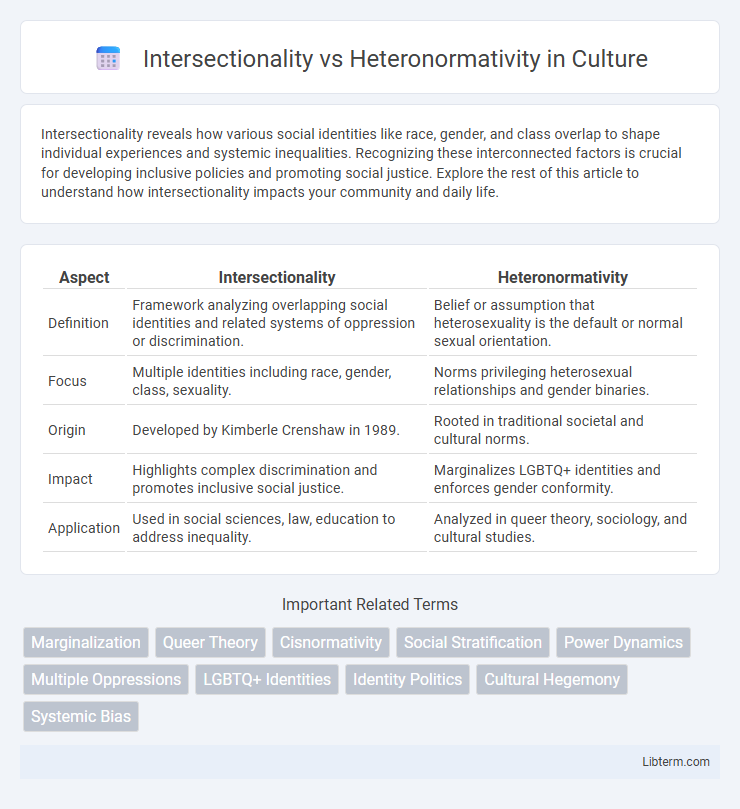Intersectionality reveals how various social identities like race, gender, and class overlap to shape individual experiences and systemic inequalities. Recognizing these interconnected factors is crucial for developing inclusive policies and promoting social justice. Explore the rest of this article to understand how intersectionality impacts your community and daily life.
Table of Comparison
| Aspect | Intersectionality | Heteronormativity |
|---|---|---|
| Definition | Framework analyzing overlapping social identities and related systems of oppression or discrimination. | Belief or assumption that heterosexuality is the default or normal sexual orientation. |
| Focus | Multiple identities including race, gender, class, sexuality. | Norms privileging heterosexual relationships and gender binaries. |
| Origin | Developed by Kimberle Crenshaw in 1989. | Rooted in traditional societal and cultural norms. |
| Impact | Highlights complex discrimination and promotes inclusive social justice. | Marginalizes LGBTQ+ identities and enforces gender conformity. |
| Application | Used in social sciences, law, education to address inequality. | Analyzed in queer theory, sociology, and cultural studies. |
Understanding Intersectionality: Foundations and Concepts
Intersectionality is a framework that examines how various social identities such as race, gender, class, and sexuality intersect to create unique experiences of oppression and privilege. Heteronormativity, the presumption that heterosexuality is the default or normal sexual orientation, often marginalizes non-heterosexual identities and obscures the complexity of intersecting social categories. Understanding the foundations of intersectionality involves recognizing the interconnected nature of social categorizations and how they contribute to systemic inequality, which challenges singular or binary views embedded in heteronormative assumptions.
Defining Heteronormativity: Origins and Impact
Heteronormativity, a concept rooted in social norms and cultural practices, posits heterosexuality as the default or normal sexual orientation while marginalizing other identities. Originating from feminist and queer theory critiques in the late 20th century, heteronormativity shapes societal expectations around gender roles, relationships, and family structures. This framework impacts intersectionality by complicating the ways multiple identities, such as race, gender, and sexuality, intersect and influence experiences of privilege and oppression.
The Interplay Between Intersectionality and Heteronormativity
Intersectionality reveals how heteronormativity disproportionately impacts individuals at the intersections of race, gender, sexuality, and class, intensifying social marginalization. The interplay between intersectionality and heteronormativity highlights systemic privileges that enforce normative gender and sexual identities while excluding queer and nonbinary experiences. Understanding this dynamic is crucial for addressing layered inequalities within LGBTQ+ communities and promoting more inclusive social policies.
Historical Evolution of Gender and Sexual Norms
The historical evolution of gender and sexual norms reveals a shift from rigid heteronormative frameworks that enforced binary gender roles and heterosexual relationships to more inclusive understandings shaped by intersectionality. Intersectionality, introduced by Kimberle Crenshaw, highlights how overlapping identities such as race, gender, class, and sexuality intersect to challenge dominant heteronormative paradigms. This evolution underscores the complexity of social identities and promotes a more nuanced analysis of oppression beyond traditional gender and sexual norms.
How Heteronormativity Shapes Social Structures
Heteronormativity shapes social structures by establishing rigid norms that prioritize heterosexual relationships and traditional gender roles, leading to systemic marginalization of LGBTQ+ identities. These norms influence institutions such as education, law, and media, perpetuating exclusion and reinforcing power imbalances. Intersectionality reveals how overlapping identities, including race, class, and gender, interact with heteronormativity, exacerbating inequality and social exclusion for multiply marginalized groups.
Intersectionality: Challenging One-Size-Fits-All Approaches
Intersectionality challenges one-size-fits-all approaches by examining how overlapping identities, such as race, gender, sexuality, and class, create unique experiences of discrimination and privilege. Unlike heteronormativity, which imposes a binary and normative framework on sexual and gender identities, intersectionality reveals the complexity of social inequalities and advocates for more inclusive policies and practices. This approach enables a deeper understanding of individual challenges and promotes tailored solutions in social justice and advocacy.
Marginalization Within LGBTQ+ Communities
Intersectionality reveals how overlapping identities such as race, gender, and class intensify marginalization within LGBTQ+ communities, exposing disparities often overlooked by heteronormative frameworks. Heteronormativity enforces a binary and normative view of sexuality and gender, perpetuating exclusion and discrimination even among queer individuals with diverse experiences. Addressing these intersecting oppressions is crucial to fostering inclusivity and equity in LGBTQ+ advocacy and support systems.
Intersectional Activism: Strategies for Inclusive Advocacy
Intersectional activism prioritizes recognizing and addressing overlapping social identities such as race, gender, sexual orientation, and class to combat systemic inequalities more effectively than traditional heteronormative frameworks. Strategies include amplifying marginalized voices, fostering coalition-building across diverse communities, and implementing policies that acknowledge multiple axes of oppression simultaneously. This inclusive approach challenges heteronormativity by promoting equity and justice beyond binary norms and singular identity politics.
Breaking Down Barriers: Moving Beyond Heteronormative Frameworks
Intersectionality challenges heteronormativity by highlighting overlapping social identities and systemic inequalities that restrict LGBTQ+ experiences within rigid gender and sexuality norms. Moving beyond heteronormative frameworks requires acknowledging diverse identities and dismantling exclusionary practices that marginalize non-heterosexual and non-cisgender individuals. Breaking down these barriers fosters inclusive policies and social environments that validate every individual's unique lived experience across race, gender, class, and sexuality.
Towards Equitable Societies: Policy Implications and Future Directions
Intersectionality highlights how overlapping social identities such as race, gender, and sexuality create unique experiences of discrimination, challenging heteronormativity's assumption of a default heterosexual norm. Policies informed by intersectionality promote inclusive frameworks that address multiple axes of inequality, essential for dismantling systemic barriers embedded in heteronormative structures. Future directions involve implementing intersectional data collection and targeted interventions to foster equitable societies that validate diverse identities and experiences.
Intersectionality Infographic

 libterm.com
libterm.com